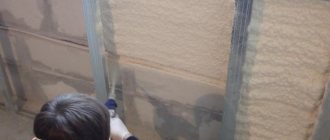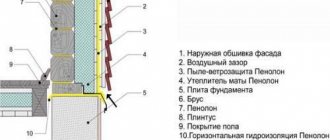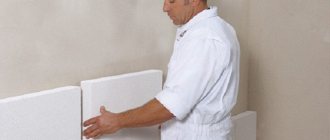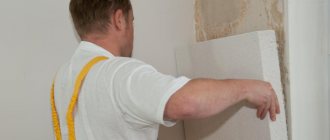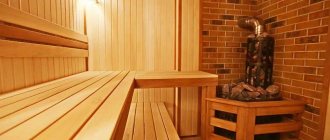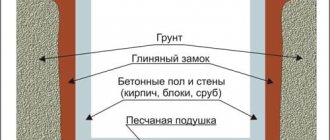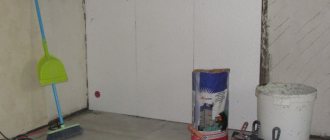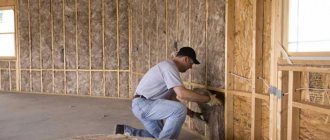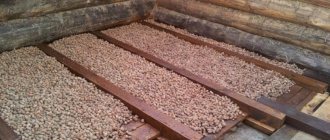Old panel houses especially need insulation. This becomes noticeable with the onset of cold weather, when the heating system cannot cope with its tasks. Today there are many ways to carry out such work, for example, insulating the walls of a panel house from the inside. This technology is relevant if external thermal insulation is impossible due to the fact that the facade of the building is not allowed to be touched.
Why insulate corner apartments?
Despite the rapid growth in the number of modern residential complexes, many Russians still live in outdated Khrushchev buildings. These buildings feature old heating systems and cannot withstand sudden weather changes. First of all, residents of corner apartments suffer from this. With the first cold snap, their homes become cold, because cool air very quickly penetrates the cracks in the walls of buildings. Another important reason for the need to install insulation lies in the layout of corner apartments. In them, not one, but two walls border the street, which further aggravates the situation of the residents. In such situations, even the presence of batteries and additional heaters cannot save the inhabitants.
The corner of the apartment is freezing
Due to severe frosts, the corners of adjacent walls of the room freeze over. As a result, plaster and wallpaper come away from the surface, which causes mold and mildew to appear. The corner rooms become very damp and an unpleasant odor develops, which interferes with normal living. Unable to withstand such conditions, sooner or later people ask the question: “How to insulate a corner bedroom or living room?” With this necessary procedure, you can not only make your stay more comfortable, but also save on heating costs. Plus, residents of the house will be protected from dangerous fungi that cause asthma and other respiratory diseases.
Penofol
Penofol is a combination of polyethylene foam and aluminum foil. This is a whole series of materials (including single-sided, double-sided, laminated, with an adhesive layer). Moreover, it can be used both in combination with other heat-insulating materials, and independently.
By the way, penofol is popular for insulating a bathhouse from the inside, and there is much more steam there than in an ordinary living room.
Penofol - alternative insulation
Choosing a material - mineral wool or polystyrene foam?
Today, in order to insulate a corner room, there are a lot of different materials. They are classified into those that are used for installation outside and those that are intended for installation inside the house. It is worth remembering that there is no universal material, because each of the insulation materials has its own advantages and disadvantages. Among the main requirements for materials are:
- high thermal conductivity;
- airtightness;
- ability to absorb moisture;
- appropriate environmental friendliness;
- flammability resistance;
- long service life.
Using lathing
To have an idea of the properties of the most popular materials, it is worth considering each of them in more detail. Mineral wool has long been considered the most popular insulation material. The main raw material for the production of this insulation is basalt. The material is one of the products with a low degree of flammability. Even if the product starts to burn, it does not emit acrid smoke that can somehow harm a person.
Installing mineral wool does not require any skills. This material is very pliable and plastic; it presses tightly against the wall and does not lag behind it for a long time. However, after a certain time, the cotton wool absorbs moisture and begins to deform. In addition, research has revealed that the material contains a small proportion of substances that are harmful to the human respiratory tract. Among other disadvantages, it is worth highlighting the large mass of the product, which makes it difficult to install alone.
Another popular material is polystyrene foam or, as it is also called, expanded polystyrene. This is polystyrene well beaten with a powerful mixer, cooled to low temperatures. The prices for this product are very low, and installation does not require skills or much physical effort. The lion's share of the material's composition is ordinary air, so it is absolutely harmless to the health of residents. This insulation is one of the few that can be used both outside and inside a building. The reason is resistance to temperature changes from -170 to +60 °C.
The insulation can be mounted on various surfaces. There is no need to use special fasteners. Another advantage of the material is its long service life. In addition to its advantages, insulation also has its disadvantages. Thus, the material cannot be used for installation in a wooden building, as it produces a large amount of condensate inside it. However, the product works great in a brick building or in buildings built from concrete blocks.
Installation of insulation inside a panel building - where to start?
Features of installing the material may vary slightly depending on the type of building. The first option we will consider is panel construction. To insulate the walls in the rooms of a corner apartment, first of all, you need to clean the surfaces. Therefore, it is best to install the material immediately before performing cosmetic or major repairs. As soon as the surfaces are cleaned, proceed with the installation of waterproofing in the form of special polymer membranes. In the vast majority of cases, their role is played by polyethylene films with a thickness of no more than 0.3 mm.
Insulation of the apartment from the inside
When stretching waterproofing, it is very important to install the material as accurately as possible, without leaving any section of the wall open. To do this, select a membrane strictly in accordance with the area of the apartment. If whole pieces of material are not available for sale, it can be purchased in the form of wide strips. The next step will be the installation of wooden or metal sheathing. An important nuance - if the structure is made of wood, it will need to be treated with an antiseptic before installation. The distance between the partitions of the sheathing should not be less than the width of one unit of insulation.
So, if you bought polyurethane foam slabs with a width of 2 m, then the distance between the partitions of the structure should also be 2 m. This way you can install insulation without leaving gaps
Installation of insulation
After installing the sheathing, it is time to install the insulation material. Most products are produced in the form of mats, one side of which is springy. When you squeeze the material, it shrinks and then immediately returns to its original shape. This makes installation of insulation much easier. After installation, the surfaces of the material are covered with vapor barrier protection. It will ensure insulation of walls and insulation from condensation. At this stage you also need to try to act as accurately as possible, without leaving cracks or grooves. For greater reliability, it is worth applying a sealant at the joints of the vapor barrier.
Technology
To insulate panel walls inside a house or apartment yourself, you need to follow the instructions. The step-by-step algorithm of actions is as follows :
- Calculate the required amount of material and purchase it.
- Prepare the surface for upcoming work. To do this, the walls are thoroughly dried.
- Remove old coverings in the form of wallpaper, paint and other decor. If plaster has been applied to the wall, it is removed down to the concrete panel.
- Clean the wall from dust and other contaminants.
- Prime the surface using a deep penetration solution. It is recommended to apply at least 2 coats of primer.
- Leave the walls until completely dry.
- Formwork is installed into which layers of insulation, for example, mineral wool, are installed.
- If formwork is not needed, insulation is attached. There is a specialized adhesive for each material.
- Seal the joints with sealant.
- Cover the structure with slabs or other finishing material.
If all technologies are followed, a comfortable temperature will be maintained inside the room. Wall insulation is good not only because it prevents its deterioration in winter, but also helps to maintain coolness in summer.
Important ! You can start insulating walls only in summer or early autumn. During the cold season, this work is not done.
Installing material in a brick building - tips for amateurs
The process of installing insulation inside a brick building has its own characteristics and is slightly different from insulating rooms in a panel building. However, there should not be any special difficulties during the work process. Since polystyrene foam is considered the most popular material for this type of work, we will consider the operating algorithm using the example of this particular insulation.
Insulation with polystyrene foam
First of all, you need to properly prepare the surface of the brick wall. If there is no plaster on it, then it must be applied. If you are starting to install insulation in an already residential area, then dismantle the wall finishing and putty before installation. If necessary, level the surface of the walls, seal all gaps and cracks and apply a primer that will penetrate into the smallest and deepest pores. It is important that the primer contains substances with antiseptic properties.
In the next step, dilute the glue. This is done strictly in accordance with the instructions for use of the composition. We apply the mixture to the surface of the walls with a smooth spatula, after which we work the layer with a tool with teeth. Without waiting for the glue to dry, take sheets of polystyrene foam and apply them one by one to the wall, pressing tightly and holding for several seconds. There is no point in using dowels to fix the insulation, since the glue will hold the material perfectly on the wall.
We install slabs without gaps
When installing each slab, make sure that there are no gaps between them! Remember that the denser the material is installed, the warmer it will be in your apartment. Further actions depend only on your plans. If you are planning to apply putty over the insulation, you will need to prime the surface before doing this. If plaster will be applied, it is necessary to install a reinforcing mesh.
Work order
When planning insulation, you must first do dismantling, removing everything that will interfere with the work. During the work, satellite antennas and galvanized canopies over the windows should be removed. Installation in solid sheets is much more reliable. When cutting material in the event of obstacles, cold bridges are formed. Despite the minimum heat loss, such bridges provoke the accumulation of dampness between the insulation and the wall.
The wall is cleaned with a coarse brush with metal bristles or a grinding machine - this way the unevenness is eliminated.
Carrying out work
More attention needs to be paid to interpanel seams. In old houses, all connections are coated with sealant for maximum insulation effect.
The panels are fastened from top to bottom, laid horizontally. Panels made of polystyrene foam and polyurethane are glued and additionally fixed with dowels - 5 pieces for each element.
The main structures are also insulated. The material is cut according to their shape.
After installing the insulator, the joints are sealed with mounting foam and masking tape. The panels are plastered and treated with special compounds.
Foam brands are the most popular insulation
In stores you can find not one, but several brands of polystyrene foam. Depending on the production method of the material, the inscriptions “PS” and “PSB” can be found on the packaging. The first means that the material was made using the press method, and the second – without pressing. In addition to this marking, there are also numbers on the foam packaging. What do they mean?
Thus, S-15 is a very dense material produced using the non-press method. This foam is excellent for exterior work in multi-story buildings; it is often used to insulate attics and roofs. Among its properties, it is worth highlighting environmental friendliness, high moisture resistance and fire resistance. S-25 PSB is another insulation material manufactured using a non-press method. This type of foam is perfect for installation in corner apartments, as it has all the qualities necessary for this. In addition, this type of polystyrene foam is often used to insulate floors and loggias.
Polystyrene foam brand S-35 PSB
If there are a large number of communications in the walls, or their installation is just planned, then for better insulation it is worth choosing foam plastic of the S-35 PSB brand. A big advantage of the material is its resistance to bad weather conditions. It is absolutely not afraid of mechanical damage and has high fire resistance. Expanded polystyrene grade S-50 PSB is considered the densest. It is often used in regions where hail often falls and strong winds blow. Such insulation is not afraid of precipitation, condensation or mechanical damage. True, its cost is quite high.
Mineral foam – how to decide?
This material is also in high demand due to its characteristics and reliability. However, not all of its brands are suitable for certain jobs. Thus, cotton wool marked P-75 will be an excellent insulation material in corner apartments. She is not afraid of moisture and fire. However, if this material is not laid correctly, it will deform very quickly due to its ability to absorb condensate vapor. Mineral wool P-125 is denser and stronger than the first type. It is often installed outside buildings made of brick and concrete in regions with mild climates. However, it is completely unsuitable for use in buildings located in the northernmost regions of Russia. Another disadvantage of this material is its high cost.
Cotton wool of the PPZh-200 and PZh-175 brands is characterized by increased density and rigidity. She is not afraid of temperature fluctuations or the influence of frequent precipitation. The only drawback is the large mass of the slabs. To insulate a home, 3–4 people are required. As for the manufacturers of the material, the products of the companies Isover, Ursa, Rockwool and Isorok are considered to be of the highest quality.
Methods of wall insulation
People have learned to insulate their homes from the inside and outside, and external insulation is more effective, since it prevents the walls from freezing and as a result collapsing (for example, plaster falls off due to freezing). You can perform thermal insulation in this way in an apartment, or even with your own hands, but only if this apartment is located on the ground floor. But if it’s higher, you’ll have to hire specialist climbers, and not everyone can afford such a pleasure.
It is advisable to install internal insulation in the apartment. It can be done with your own hands, although there is still a disadvantage - the useful living space will be reduced by the thickness of the insulation.


